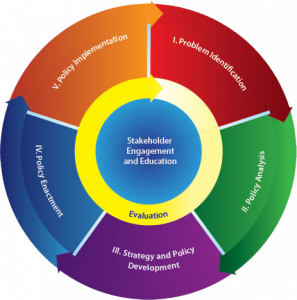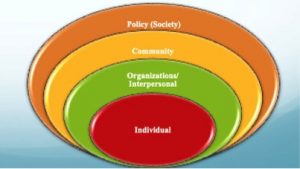1
Policy is a process, meaning, it is constantly in need of revision. Creating policy is a cyclical, non-linear, endeavor. As society evolves, so do the policies that govern it. Philosophically, one might observe that a policy can only be as inclusive and advanced as the society that enacts it.
Five core steps in the policy process are:
- Problem identification
- Policy analysis
- Strategy and Policy development
- Policy Enactment
- Policy Implementation

[Alt text: A visual depiction of the cyclical process of policy. The arrows of each stage point to the next; since the stages and arrows are in a circle, the visual depicts that the process is neverending. The outer most circle begins with problem identification, leading to policy analysis then strategy and policy development, then policy enactment, followed by policy implementation–which then continues the cycle and points towards problem identification. And thus, the cycle continues. The middle circular arrow shows the evaluation continues throughout all the aforementioned stages. The innermost circle states “stakeholder engagement, education and evaluation” and this is a constant throughout the whole cycle.]
Source: https://www.cdc.gov/policy/analysis/process/
Policy is a reflection of society
Policy development can be considered an open system, impacted by:
- Societal beliefs (culture/values)
- Economics
- Politics
- Stakeholders
The feedback loop described earlier in the policy process also depicts how policy is an open system. The healthcare sector is also an open system– it interacts with and is impacted by the environment. Therefore, health policy directly affects health.
An adaptation of the Socioecological Model (SEM) illustrates that policy is impacted by multiple levels of society, and in fact, policy is a reflection of society.

[Alt text: A visual depiction of the socioecological model in which 4 circles overlap. The innermost circle states, “Individual”, a larger circle envelopes it and states “organizational/interpersonal”, a third circle envelopes both of these two circles and is labeled “community”, the final largest enveloping circle contains all circles and states “policy (society)”. ]
Let’s take a moment and consider this statement one more time before we move on: policy is a reflection of society. What does that mean? Is the reverse: society is a reflection of policy, also true?
Society is constantly evolving. Political scientists may argue that we are constantly striving towards utopia, an ideal society. In the United States of America, the idea is to “form a more perfect union”–and that means daily, or at the very least, with each election and new law. Thus, the laws that exist are simply a reflection of the society in which they continue to be upheld. When society enforces and thus, affirms, the laws in existence, they continue on–until they are challenged. It is in these challenges- or “problem identification” stages- that society becomes introspective. The “law of the land” is not an ultimate truth: it only derives its power from the people from which it came. Again, we are talking about American politics/democracy here. If society is a reflection of policy– if the only reason citizens are adhering to a policy is because of the simple fact that “it’s the law” and there is not agreement from the majority/consensus that the law makes sense/saves lives/is worth keeping, then what is actually at play is dictation. As societies evolve, we may witness how the reverse (when society is a reflection of policy) is confronted. The 2022 protests in Iran against the hijab law is illustrative of how a society that has long been imposed upon by policy is being challenged by the populace. (Note: The hijab law mandates that women wear a religious head covering while in public, read more at https://www.bbc.com/news/world-middle-east-63128184).
Therefore, it can be argued that no, the reverse- “society is a reflection of policy”- is not true….or at least may not be true for very long.

